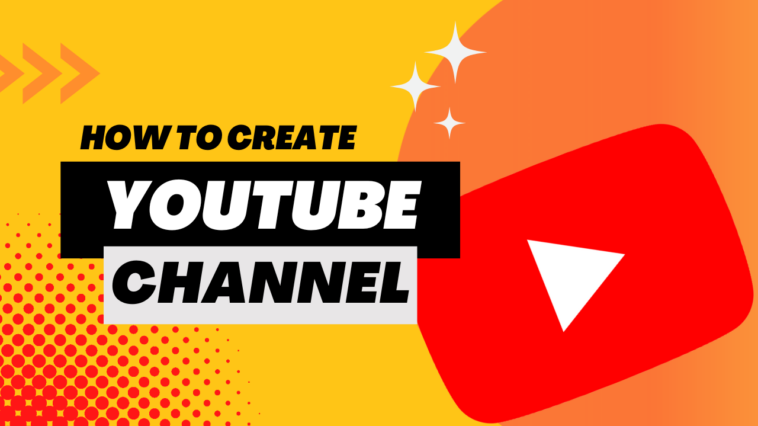Opening a YouTube channel is relatively straightforward. Here’s a step-by-step guide to help you get started:
- Sign in or Create a Google Account: If you don’t already have one, you’ll need to sign in to or create a Google Account. This account will serve as your login for accessing YouTube and other Google services.
- Go to YouTube: Once you’re signed in to your Google Account, go to the YouTube website (www.youtube.com).
- Access YouTube Studio: In the top-right corner of the YouTube homepage, you’ll see your profile icon. Click on it, and then click on “YouTube Studio.” This is where you’ll manage your channel.
- Create Your Channel: In YouTube Studio, you’ll see options on the left sidebar. Click on “Settings” (the gear icon) and then click on “Channel” and then “Other Features.” Next, click on “Create a new channel.” Follow the prompts to set up your channel.
- Enter Channel Details: You’ll be prompted to enter details for your new channel, including the name and description. Choose a name that reflects your content and is easy to remember. Write a brief description that summarizes what your channel is about.
- Upload Channel Art and Profile Picture: Customize your channel by uploading channel art (banner) and a profile picture. Channel art should be eye-catching and represent your brand or content. Your profile picture should be recognizable and representative of you or your brand.
- Set Up Channel Layout: Customize your channel layout by adding sections and playlists to organize your content. You can feature specific videos, playlists, or channels on your homepage to highlight your best content.
- Create Your First Video: Once your channel is set up, it’s time to create your first video. Use a good camera and microphone for recording, and make sure your video is well-lit and has clear audio. Choose a topic that aligns with your channel’s theme and start creating.
- Upload Your Video: Click on the camera icon at the top of the YouTube homepage and select “Upload Video.” Choose the video file from your computer, add a title, description, and tags, and select the appropriate category for your video.
- Publish Your Video: Once your video is uploaded and all the details are filled out, click on the “Publish” button to make your video live on your channel.
- Promote Your Channel: Share your channel and videos on social media, forums, and other platforms to attract viewers. Engage with your audience by responding to comments and participating in discussions related to your content.
- Consistency is Key: To grow your channel, it’s important to be consistent with your uploads. Stick to a regular schedule and keep producing high-quality content that resonates with your audience.
Remember, building a successful YouTube channel takes time and effort, so stay patient and keep refining your content and strategy as you learn and grow. Good luck with your new channel!
Creating a successful YouTube channel requires strategic planning, dedication, and consistency. Here’s a detailed guide on how to get started:
- Define Your Niche: Choose a specific topic or niche for your channel. It could be anything from technology reviews to cooking tutorials, but it’s essential to focus on something you’re passionate about and knowledgeable in. This will help you attract a targeted audience.
- Research Your Audience: Understand who your target audience is and what type of content they enjoy. Look at other successful channels in your niche to see what works and what doesn’t. Analyze their content, engagement metrics, and audience demographics to gather insights.
- Create a Brand Identity: Develop a unique brand identity for your channel, including a memorable name, logo, and channel art. Consistent branding helps viewers recognize your channel across different platforms and builds trust and credibility.
- Plan Your Content: Create a content strategy outlining the types of videos you’ll produce, how often you’ll upload, and the format and style of your content. Consider creating a content calendar to stay organized and ensure a steady stream of uploads.
- Produce High-Quality Videos: Invest in decent recording equipment, such as a good camera, microphone, and lighting setup. Focus on producing high-quality videos with clear audio and crisp visuals. Pay attention to editing to make your videos engaging and professional-looking.
- Optimize for Search: Optimize your video titles, descriptions, and tags with relevant keywords to improve your visibility in YouTube search results. Use keyword research tools to identify popular search terms in your niche and incorporate them naturally into your content.
- Engage with Your Audience: Build a community around your channel by responding to comments, asking for feedback, and interacting with your viewers on social media platforms. Engaging with your audience fosters loyalty and encourages them to become repeat viewers and subscribers.
- Promote Your Channel: Use social media, email newsletters, and collaborations with other YouTubers to promote your channel and reach a wider audience. Cross-promotion can help attract viewers from related channels who may be interested in your content.
- Monetize Your Channel: Once you’ve built a substantial audience, consider monetizing your channel through advertising, sponsorships, merchandise sales, or channel memberships. Enable monetization features such as ads and memberships in your YouTube settings.
- Analyze and Adapt: Regularly analyze your channel analytics to track your progress and identify areas for improvement. Pay attention to metrics like watch time, audience retention, and subscriber growth to understand what’s working well and what needs adjustment.
Remember, building a successful YouTube channel takes time and effort, so stay patient and persistent. Keep experimenting with different types of content and strategies until you find what resonates best with your audience. And most importantly, have fun creating and sharing your content!
Here are 50 tips for running a successful YouTube channel:
- Find Your Niche: Choose a specific topic or niche that you’re passionate about and knowledgeable in.
- Create a Content Calendar: Plan your video uploads in advance to maintain consistency.
- Invest in Quality Equipment: Use a good camera, microphone, and lighting for better video and audio quality.
- Focus on Audio Quality: Viewers often forgive lower video quality but not poor audio, so invest in a quality microphone.
- Master Video Editing: Learn basic video editing techniques to enhance the quality of your videos.
- Optimize Video Titles: Use descriptive and engaging titles that include relevant keywords to attract viewers.
- Craft Compelling Thumbnails: Create eye-catching thumbnails that accurately represent your video content.
- Write Detailed Descriptions: Use your video description to provide additional context, links, and relevant information.
- Utilize Tags: Add relevant tags to your videos to improve searchability and discoverability.
- Engage with Your Audience: Respond to comments, ask questions, and encourage viewer interaction.
- Collaborate with Other YouTubers: Collaborate with creators in your niche to reach new audiences and grow your channel.
- Promote Your Videos on Social Media: Share your videos on platforms like Twitter, Facebook, and Instagram to increase visibility.
- Create a Channel Trailer: Introduce new viewers to your channel with a short, engaging trailer that highlights your content.
- Use End Screens and Cards: Encourage viewers to watch more of your videos or subscribe by using end screens and cards.
- Customize Your Channel Layout: Organize your channel with playlists and sections to make it easy for viewers to navigate.
- Optimize Your Channel About Page: Write a compelling channel description and include links to your social media profiles and website.
- Stay Consistent with Upload Schedule: Stick to a regular upload schedule to keep your audience engaged and coming back for more.
- Study YouTube Analytics: Use YouTube Analytics to track your channel’s performance and identify areas for improvement.
- Experiment with Different Video Lengths: Test different video lengths to see what works best for your audience.
- Create Evergreen Content: Produce content that remains relevant and valuable to viewers over time.
- Host Live Streams: Interact with your audience in real-time by hosting live streams on your channel.
- Create Playlists: Group related videos into playlists to encourage viewers to watch more of your content.
- Promote Subscriber Benefits: Encourage viewers to subscribe by highlighting the benefits they’ll receive.
- Cross-Promote Your Videos: Mention related videos or playlists within your content to keep viewers engaged.
- Optimize Video Thumbnails for Mobile: Ensure your thumbnails are clear and readable on mobile devices.
- Create Compelling Intros: Hook viewers from the start with a captivating intro that sets the tone for your video.
- Ask for Engagement: Encourage viewers to like, comment, and share your videos to boost engagement.
- Host Q&A Sessions: Connect with your audience by answering their questions in dedicated Q&A videos.
- Attend YouTube Events and Conferences: Network with other creators and learn from industry experts at YouTube events.
- Promote User Engagement on Community Tab: Use the Community tab to share updates, polls, and behind-the-scenes content with your audience.
- Respond to Trending Topics: Stay current with trending topics in your niche and create timely content around them.
- Optimize Videos for SEO: Research keywords and optimize your video titles, descriptions, and tags for better search engine visibility.
- Create Eye-Catching Channel Art: Use attractive channel art that reflects your brand and personality.
- Host Giveaways and Contests: Encourage audience participation by hosting giveaways or contests on your channel.
- Create How-To and Tutorial Videos: Share your expertise with instructional videos that provide value to your audience.
- Share Personal Stories and Experiences: Connect with your audience on a personal level by sharing stories and experiences related to your niche.
- Stay Authentic: Be genuine and authentic in your content to build trust and rapport with your audience.
- Share Your Journey: Document your journey as a creator and share the ups and downs with your audience.
- Monitor Trends and Algorithm Changes: Stay informed about changes to YouTube’s algorithm and adjust your strategy accordingly.
- Diversify Your Content: Experiment with different types of content, such as vlogs, reviews, and tutorials, to appeal to a wider audience.
- Create Compelling Calls to Action: Clearly communicate what action you want viewers to take, whether it’s subscribing, liking, or sharing your videos.
- Utilize YouTube Shorts: Experiment with short-form vertical videos on YouTube Shorts to reach new audiences.
- Optimize Your Channel for Mobile: Ensure your channel and videos are optimized for mobile viewing.
- Host Guest Interviews: Invite guests to your channel for interviews or collaborations to offer fresh perspectives and attract their audience.
- Promote Your Merchandise: If you have merchandise, promote it in your videos and on your channel to drive sales.
- Optimize Your Video End Screen: Use the end screen to promote related videos, playlists, or subscriptions.
- Stay Up-to-Date with YouTube Policies: Familiarize yourself with YouTube’s policies and guidelines to avoid potential issues.
- Join YouTube Communities and Forums: Participate in YouTube communities and forums to connect with other creators and learn from their experiences.
- Seek Feedback and Iterate: Regularly solicit feedback from your audience and use it to improve your content and channel.
- Stay Persistent and Patient: Building a successful YouTube channel takes time and effort, so stay persistent and patient on your journey.
Remember, there’s no one-size-fits-all approach to YouTube success, so experiment with different strategies and techniques to find what works best for you and your audience.
Here are some potential keywords that you might consider for your YouTube channel, based on different niches:
- Technology:
- Tech Reviews
- Gadgets
- Electronics
- Tech News
- Product Unboxing
- How-to Guides
- Software Tutorials
- Cooking/Food:
- Recipes
- Cooking Tutorials
- Food Reviews
- Healthy Eating
- Baking
- Meal Prep
- International Cuisine
- Fitness/Health:
- Workout Routines
- Fitness Tips
- Nutrition Advice
- Weight Loss
- Yoga
- Bodybuilding
- Healthy Living
- Travel:
- Travel Vlogs
- Destination Guides
- Budget Travel Tips
- Adventure Travel
- Solo Travel
- Travel Hacks
- Cultural Experiences
- Gaming:
- Let’s Play
- Game Reviews
- Gaming Tutorials
- Walkthroughs
- Esports
- Game Development
- Gaming News
- Beauty/Fashion:
- Makeup Tutorials
- Beauty Reviews
- Fashion Hauls
- Style Tips
- Skincare
- Haircare
- Makeup Trends
- DIY/Crafts:
- DIY Projects
- Craft Tutorials
- Home Decor Ideas
- Crafting Tips
- Upcycling
- Sewing
- Knitting/Crocheting
- Education/E-learning:
- Educational Videos
- Online Learning
- Study Tips
- Academic Subjects (e.g., Math, Science)
- Language Learning
- Exam Preparation
- Tutoring
- Parenting/Family:
- Parenting Tips
- Family Vlogs
- Child Development
- Pregnancy Advice
- Family Activities
- Parenting Hacks
- Homeschooling
- Entertainment/Pop Culture:
- Celebrity News
- Movie Reviews
- TV Show Recaps
- Music Videos
- Celebrity Interviews
- Pop Culture Commentary
- Memes and Trends
Remember to choose keywords that are relevant to your channel’s content and target audience. These keywords can help improve the discoverability of your videos on YouTube.
Creating effective YouTube channel topic keywords involves understanding your channel’s niche, target audience, and the type of content you plan to produce. Here’s how you can create YouTube channel topic keywords:
- Identify Your Niche: Determine the main theme or topic of your YouTube channel. This could be anything you’re passionate about or knowledgeable in, such as cooking, gaming, beauty, technology, fitness, or travel.
- Research Popular Keywords: Use keyword research tools like Google Keyword Planner, SEMrush, or Ubersuggest to find popular keywords related to your niche. Look for keywords with high search volume and low competition.
- Brainstorm Topics: Make a list of topics and subtopics within your niche that you plan to cover on your channel. Think about what your target audience is interested in and what questions they might have.
- Use Long-Tail Keywords: Long-tail keywords are specific phrases that are more targeted and have less competition. Incorporate long-tail keywords into your channel topic keywords to attract a more relevant audience.
- Consider Search Intent: Think about the intent behind the keywords your audience might use to search for content like yours. Are they looking for tutorials, reviews, how-to guides, or entertainment? Tailor your keywords to match the search intent of your audience.
- Include Brand Keywords: If you have a brand name or a unique selling proposition for your channel, include relevant brand keywords in your topic keywords. This will help you build brand awareness and differentiate your channel from others in the same niche.
- Be Specific and Descriptive: Use descriptive keywords that accurately represent the content of your videos. Avoid using broad or generic keywords that don’t provide much context.
- Use Relevant Tags: Once you’ve chosen your topic keywords, use them as tags when uploading your videos to YouTube. Tags help YouTube understand the content of your videos and improve their visibility in search results.
- Analyze Competitors: Look at other YouTube channels in your niche and see what keywords they’re using in their video titles, descriptions, and tags. This can give you ideas for relevant keywords to use on your own channel.
- Test and Iterate: Don’t be afraid to experiment with different keywords and see what works best for your channel. Monitor your video performance and analytics to see which keywords are driving the most views and engagement, and adjust your strategy accordingly.
By following these steps, you can create YouTube channel topic keywords that help optimize your channel for search and attract the right audience to your content.





